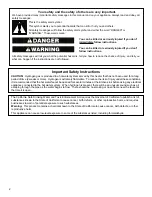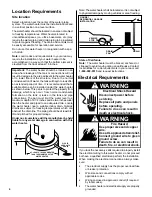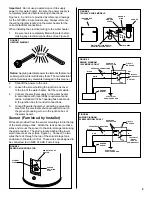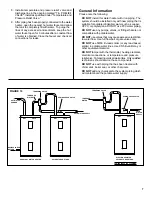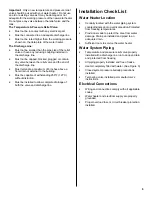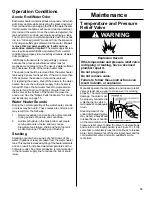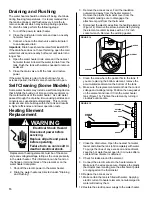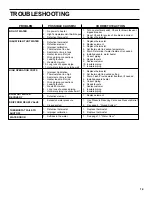
Important:
Only a new temperature and pressure relief
valve should be used with your water heater. Do not use
an old or existing valve as it may be damaged or not
adequate for the working pressure of the new water heater.
Do not place any valve between the relief valve and the
tank.
The Temperature & Pressure Relief Valve:
·
Must not be in contact with any electrical part.
·
Must be connected to an adequate discharge line.
·
Must not be rated higher than the working pressure
shown on the data plate of the water heater.
The Discharge Line:
·
Must not be smaller than the pipe size of the relief
valve or have any reducing coupling installed in
the discharge line.
·
Must not be capped, blocked, plugged or contain
any valve between the relief valve and the end of
the discharge line.
·
Must terminate a maximum of 6 inches above a
floor drain or external to the building.
·
Must be capable of withstanding 250°F (121°C)
without distortion.
·
Must be installed to allow complete drainage of
both the valve and discharge line.
Installation Check List
Water Heater Location
·
Centrally located with the water piping system.
·
Located indoors and in a vertical position. Protected
from freezing temperatures.
·
Provisions made to protect the area from water
damage. Drain pan installed and piped to an
adequate drain.
·
Sufficient room to service the water heater.
Water System Piping
·
Temperature and pressure relief valve properly
installed with a discharge line run to an open drain
and protected from freezing.
·
All piping properly installed and free of leaks.
·
Heater completely filled with water. (See Figure 3)
·
Closed system pressure buildup precautions
installed.
·
Tempering valve installed per manufacturers
instructions.
Electrical Connections
·
Wiring and connections comply with all applicable
codes.
·
Water heater and electrical supply are properly
grounded.
·
Proper overload fuse or circuit breaker protection
installed.
9


